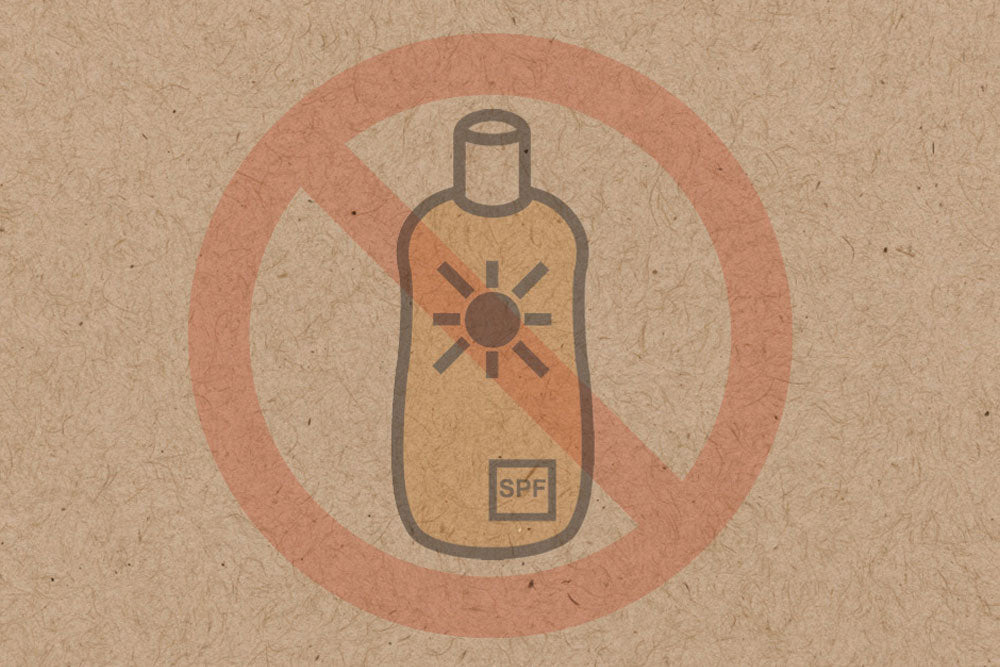Breaking Down Chemical Sunscreens


You’ve probably heard not to apply any product on your skin that you can’t eat. If you’re thinking that sounds crazy, remember that your skin is the body’s largest organ. That means any chemical (skincare or cosmetic product) you put on your skin seeps directly into your body. Still sound crazy?
According to the Environmental Working Group (EWG), the average American woman uses 12 personal care products and cosmetics a day, containing about 168 different chemicals. Although men tend to use fewer products, the EWG reports that they’re still exposed to about 85 chemicals per day. While it might sound like a high number of products to use every day, when you stop to think about all the products you use or come into contact with (shampoo, conditioner, body soap, hand soap, moisturizer, sunscreen, etc…) 12 really doesn’t sound like that high of a number.
While tons of products many people use each day are full of harmful ingredients for both our bodies and the environment, our focus is on breaking down what’s really inside your chemical sunscreen bottle. Because most of us aren’t scientists, it’s hard to know at first glance what the ingredients in chemical sunscreen mean and which are harmful to our bodies.

That’s why we’re breaking down the five worst offenders on big brands’ chemical ingredients lists to help you stay out of harm’s way.
Offender 1: Oxybenzone
According to the EWG, the most problematic of all sunscreen chemicals used in the US is oxybenzone. While this ingredient is banned for use in Sweden, it’s shockingly found in thousands of sunscreen products in the US. If you’re surprised that the FDA doesn’t regulate chemical sunscreens, you’re not alone, which is why the EWG works to provide consumers with as much information as possible to make informed and healthy sunscreen-buying choices.
The EWG highly recommends that consumers purchase only sunscreens without oxybenzone, as it penetrates the skin with side effects including allergic reactions and hormone disruption. It has also been shown to produce free radicals and is therefore believed to have contributed to the recent rise of Melanoma cases among sunscreen users. Some studies have also shown that oxybenzone behaves similarly to estrogen, suggesting that it could lead to breast cancer.
What’s bad for our bodies is often bad for nature, so it’s not surprising that oxybenzone has also been linked to playing a role in coral bleaching. Sadly, every year we lose more and more coral reefs to bleaching, and recovery of these habitats is rare. Archives of Environmental Contamination and Toxicology reports that oxybenzone is “toxic to coral even at extremely low concentrations of 62 parts per trillion, equal to the ratio of a single drop to 6½ Olympic-size swimming pools.”
Offender 2: Retinyl Palmitate
Retinyl palmitate (a form of Vitamin A) is commonly added to skincare products to help reverse the effects of aging from UV exposure. While this is considered safe in many products like night creams, some studies have suggested that when applied to skin exposed to the sun, retinyl palmitate may actually speed development of cancerous cells and tumors. In sunlight, the retinol compounds break down, producing free radicals that may damage DNA and could even cause cancer. This is clearly troubling, as the EWG reports that in 2015, the sunscreen industry added vitamin A to about 18 percent of sunscreens, 17 percent of moisturizers (with SPF), and 13 percent of all SPF lip products.
Offender 3: Octinoxate
Octinoxate is currently one of the most widely used UVB-blocking ingredients in the mainstream sunscreen industry. While it’s supposed to protect users from harmful side effects of sun exposure, it has actually been shown to produce free radicals, which damage skin cells and cause premature aging.
Studies have shown that octinoxate could negatively affect the endocrine system, which regulates the body’s hormonal balance. It has also been shown to increase production of estrogen in cells, which is linked to the development of breast cancer and is harmful to ocean wildlife that comes into contact with it. Other side effects of octinoxate are the possible interruption of normal thyroid functioning and damaging effects on the male reproductive system.
Offender 4: Parabens
Parabens are a type of preservative commonly found in skincare products and sunscreens. The potential dangers of parabens have been highly publicized in recent years, and many consumers are now singling this ingredient out as harmful and seeking products with more natural preservatives. While no conclusive evidence has been drawn one way or the other, some studies have found that parabens are linked to both breast cancer in women and sperm cell damage in men.
One of the biggest concerns surrounding paraben preservatives is that they are more dangerous to children than adults. The Centers for Disease Control and Prevention report that 90% of babies are exposed to parabens through contaminated breast milk and blood. These chemicals can also seep directly into the womb when a mother rubs a paraben-containing product on her belly.
Offender 5: Homosalate
Homosalate is added to chemical sunscreens to absorb UV rays and assist the sunscreen in penetrating your skin. However, once your skin absorbs the chemical, it accumulates in the body faster than we can expose of it. It then quickly becomes toxic and disrupts our hormones.
Its quick absorption rate has also been shown to enhance the absorption of pesticides in the body.
When you compare the side effects of these five potentially harmful chemical ingredients found in big brands’ sunscreen to the benefits of the organic and natural ingredients found in MANDA, the healthy and eco-friendly choice is clear and simple. Let us know in the comments if there are other nasty chemical sunscreen ingredients we missed!


